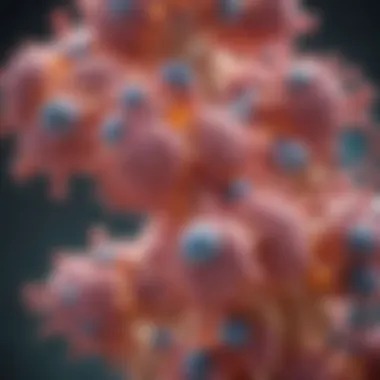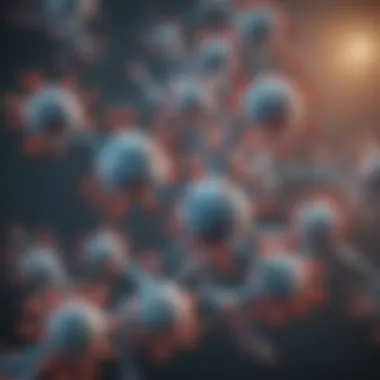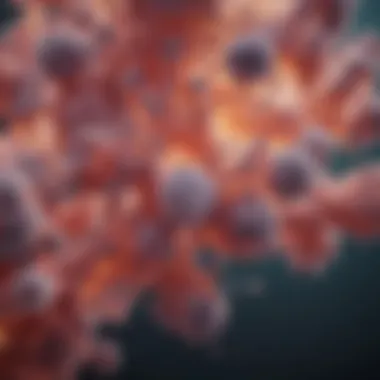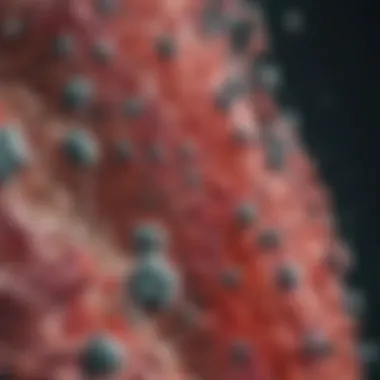Surfactant Protein C Antibody: Insights and Implications


Intro
Surfactant Protein C (SP-C) antibodies represent a crucial area of study within pulmonary biology. Their role in lung health and disease is significant. Understanding both the biology of SP-C and the interactions involving its antibodies can aid in the diagnosis and treatment of various respiratory conditions. This section will delve into the foundational aspects of SP-C antibodies, helping to outline their implications and insights in the field.
Research Overview
Methodological Approaches
Research on SP-C antibodies utilizes various methodological approaches. Many studies employ immunohistochemistry for localization and quantification of SP-C within lung tissues. Enzyme-linked immunosorbent assays (ELISA) also play a key role, offering a means to detect antibody levels in serum. These techniques provide a robust framework for exploring the presence and functionality of SP-C antibodies in clinical samples.
Additionally, genetic analyses are often conducted to understand the role of SP-C in lung biology. Some researchers have used animal models to examine the effects of SP-C deficiency. This multifaceted approach enhances our understanding of SP-C antibodies, further illuminating their clinical significance.
Significance and Implications
The significance of SP-C antibodies cannot be overstated. These antibodies can signal lung disease presence. For example, in conditions like interstitial lung disease, the presence of anti-SP-C antibodies may correlate with disease severity. This makes them a valuable biomarker for diagnosis and prognosis.
Moreover, SP-C antibodies have potential therapeutic implications. Research suggests they may play a role in the modulation of lung inflammation. This insight opens avenues for targeted therapies that could ameliorate inflammatory responses in pulmonary diseases.
Understanding the dynamics of SP-C antibodies may revolutionize how we approach lung pathology, facilitating improved diagnostic and therapeutic strategies.
Current Trends in Science
Innovative Techniques and Tools
In recent years, advancements in technology have catalyzed research on SP-C antibodies. High-throughput sequencing and mass spectrometry offer innovative tools for the comprehensive study of surface markers and antibody profiles. These methods can reveal nuanced interactions between antibodies and immune responses in the lungs.
Furthermore, the rise of personalized medicine has prompted a reevaluation of antibody-based therapies. By understanding individual variations in SP-C antibody responses, clinicians can better tailor treatments for patients. This trend highlights a shift towards more precise medical interventions in pulmonary care.
Interdisciplinary Connections
The study of SP-C antibodies is not limited to pulmonary biology; it intersects with immunology, genetics, and pharmacology. Collaborative research efforts can lead to breakthroughs in our understanding of how SP-C antibodies influence lung health. For instance, interdisciplinary teams can share insights on genetic predispositions affecting antibody production and responses.
In summary, SP-C antibodies offer valuable insights into lung health and disease. Their study encompasses a variety of methodological approaches and innovative trends. By merging information from different fields, we deepen our understanding and pave the way for future research and therapies.
Prologue to Surfactant Proteins
Surfactant proteins play a critical role in the respiratory system, contributing to the homeostasis of lung function. Understanding these proteins is essential, especially for those working in fields such as pulmonology, immunology, and molecular biology. The focus on surfactant protein C (SP-C) is particularly relevant in light of recent research into its implications for various pulmonary diseases. This section will provide a foundational understanding of what surfactant proteins are and why they are significant in respiratory health.
Definition of Surfactant Proteins
Surfactant proteins are specific proteins found within the pulmonary surfactant, a complex mixture composed mainly of lipids and proteins. They are crucial for reducing surface tension in the alveoli, preventing lung collapse at the end of expiration. The three main types of surfactant proteins are SP-A, SP-B, and SP-C. Each plays distinct roles, with SP-C being essential for the proper function and stability of surfactant layers. Without these proteins, the lungs cannot maintain their necessary elasticity and structure, leading to compromised respiratory function.
Functions of Surfactant Proteins
The functions of surfactant proteins are multifaceted, facilitating several key processes:
- Reducing Surface Tension: By lowering surface tension in the alveoli, surfactant proteins prevent their collapse, ensuring effective gas exchange.
- Immune Defense: Surfactant proteins play a role in innate immunity. They help to modulate the immune response in the lungs by attracting immune cells to areas of infection.
- Facilitating Lung Development: During fetal development, surfactant proteins are critical for the formation of alveoli and the maturation of the lungs.
- Restoring Lung Function: In cases of lung injury, surfactant proteins can aid in the restoration of normal lung mechanics and function.
Understanding these functions is vital for grasping how abnormalities in surfactant protein C can lead to serious respiratory conditions.
Understanding Surfactant Protein


Surfactant Protein C (SP-C) plays a crucial role in maintaining the functionality of the respiratory system. Understanding its functions and properties is essential for appreciating how it impacts lung health and disease. SP-C is one of the surfactant proteins that contribute to the surface tension reducing effects of pulmonary surfactant. Its importance cannot be understated, as it directly influences gas exchange efficiency and stability in the alveoli.
Role in Lung Function
The primary function of SP-C in lung biology is to help in lowering the surface tension within the alveoli. This reduction in surface tension is vital for preventing alveolar collapse, thereby maintaining adequate lung volumes during respiration. Without SP-C, the lungs would not function optimally, leading to increased work of breathing and potential respiratory failure.
Moreover, SP-C has a role beyond mere surface tension reduction. It also facilitates the spread of surfactant and enhances the adsorption of other surfactant proteins. This interplay among surfactant components is critical, especially during the dynamic process of breathing, as SP-C ensures that the surfactant layer remains intact and functional. A disrupted or inadequate production of SP-C can lead to significant lung pathologies, severely affecting oxygenation and increasing susceptibility to infections.
In summary, SP-C is pivotal for maintaining lung integrity and function. It is actively involved in ensuring efficient gas exchange, which is fundamental for overall health. Thus, understanding its function offers a window into broader pulmonary physiology and pathology.
Molecular Structure of SP-C
Molecularly, Surfactant Protein C is intriguing due to its compact structure. It consists mainly of hydrophobic amino acids, which allow it to interact effectively with lipids in the pulmonary surfactant layer. This hydrophobic characteristic is essential for reducing surface tension, and it allows SP-C to integrate into the surfactant membrane easily.
SP-C is synthesized as a precursor protein that undergoes post-translational modifications. The mature form of SP-C is a small protein, typically about 4 kDa. The structure of SP-C includes a central hydrophobic domain flanked by polar regions. This arrangement is crucial for its function in the physiological environment of the lung.
"SP-C’s unique molecular architecture enables it to play a critical role in surfactant biology, influencing both stability and surface tension properties of the alveoli."
The orientation of SP-C within the surfactant layer is also important. It assists in the formation of the liquid film that reduces surface tension and prevents the alveoli from collapsing during expiration. Understanding this molecular structure helps researchers identify how changes in SP-C can contribute to diseases like pulmonary alveolar proteinosis or acute respiratory distress syndrome, revealing potential therapeutic targets.
Antibodies Against Surfactant Protein
Understanding antibodies against surfactant protein C is critical for grasping their broader implications in pulmonary health. These antibodies serve as a window into the complexities of the immune response related to lung conditions. Specifically, the role of SP-C antibodies underscores their significance in diagnosis, progression, and response to treatment in various lung diseases, enabling researchers and clinicians to tailor strategies accordingly.
Mechanism of Antibody Production
The production of antibodies against surfactant protein C occurs through a biological process closely tied to the immune system's response. When the body detects aberrations or foreign entities affecting surfactant proteins, it mobilizes an immune response. B cells, a type of white blood cell, play a pivotal role by recognizing specific antigens presented by affected lung tissues. Once activated, these B cells undergo proliferation and differentiation into plasma cells, which are responsible for secreting antibodies.
This process involves several stages:
- Antigen Recognition: B cells identify SP-C as a target, typically due to its altered expression in diseased conditions.
- Activation: Following recognition, B cells are activated by helper T cells, which provide necessary signals.
- Differentiation and Production: Once activated, B cells evolve into plasma cells, producing specific antibodies against SP-C.
Beyond just identification, the presence of these antibodies can inform on potential pathologies, hinting at underlying autoimmune processes or lung injuries. Therefore, the interplay of antigen recognition and antibody production forms a crucial backbone in understanding the clinical relevance of SP-C antibodies.
Clinical Relevance of SP-C Antibodies
The clinical implications of surfactant protein C antibodies are multifaceted and significant. They are crucial for diagnosing and monitoring various pulmonary conditions. For instance, elevated levels of SP-C antibodies often correlate with pulmonary alveolar proteinosis and other interstitial lung diseases, reflecting an autoimmune response where the immune system mistakenly targets the lung's surfactant proteins.
Key clinical significances of SP-C antibodies include:
- Diagnostic Marker: They serve as biomarkers for certain pulmonary disorders, aiding in differential diagnosis.
- Disease Monitoring: Changes in antibody titers can provide insight into disease progression or response to therapy, guiding clinical decisions.
- Treatment Response: Understanding the presence and levels of these antibodies helps in predicting how a patient may react to certain treatments, such as corticosteroids or other immunomodulatory therapies.
"The detection of SP-C antibodies can enhance the diagnostic landscape for lung diseases, providing clarity in perplexing cases."
Diagnostic Applications of SP-C Antibodies
The role of surfactant Protein C (SP-C) antibodies in diagnostics cannot be understated. Their applications extend significantly within pulmonary medicine, aiding in the identification and management of various lung diseases. As researchers continue to uncover the complexities of SP-C, understanding how these antibodies can be utilized diagnostically is of paramount importance. There are several facets to consider, including diagnostic tests and methodologies, as well as the interpretation of results.
Diagnostic Tests and Methodologies
Modern diagnostic tests for SP-C antibodies involve various techniques which facilitate accurate identification of these antibodies within patient samples. Common methods include:


- Enzyme-Linked Immunosorbent Assay (ELISA): This is a widely used test that measures the concentration of antibodies in blood or other bodily fluids. It employs specific antigens to capture SP-C antibodies, allowing for quantification.
- Western Blotting: This method is used to detect specific proteins in a sample, confirming the presence of SP-C antibodies by visualizing the binding of antibodies to the target proteins.
- Immunofluorescence: This technique offers a qualitative analysis and is used to visualize SP-C antibodies in tissue samples by employing fluorescently labeled secondary antibodies.
These methodologies have improved the diagnostic accuracy for conditions associated with SP-C antibodies, providing a framework for subsequent investigations.
Interpretation of Diagnostic Results
Interpreting the results from SP-C antibody tests requires expertise and a comprehensive understanding of clinical context. A positive result could indicate various pulmonary conditions, but specificity in interpretation is crucial. Important considerations include:
- Clinical Correlation: Results must be integrated with clinical symptoms and patient history. Elevated SP-C antibody levels may correlate with specific lung diseases, but not exclusively.
- False Positives/Negatives: Awareness of potential false positive and negative results is essential. Factors such as technical variability or sample quality can confound results, requiring further confirmatory testing or clinical judgement.
- Population Variations: It’s important to understand that reference ranges might vary based on demographic and population characteristics.
"Accurate interpretation of diagnostic results plays a vital role in clinical decision-making and treatment pathways."
In summary, the diagnostic applications of SP-C antibodies provide an effective means to unravel complex pulmonary conditions. The methodologies utilized help elucidate the presence of these antibodies, while careful interpretation of the results ensures that appropriate clinical actions can follow.
Surfactant Protein Antibody in Disease Models
Understanding the implications of surfactant protein C (SP-C) antibodies in disease models is crucial for several reasons. It highlights how specific antibodies can influence lung health and disease pathology. Increasing knowledge in this area aids in the development of innovative therapies and diagnostic methods, contributing to overall improvements in patient care.
Pulmonary Alveolar Proteinosis
Pulmonary alveolar proteinosis (PAP) is a rare condition characterized by the accumulation of surfactant in the alveoli, leading to impaired gas exchange. It often results from dysfunction or deficiency of SP-C. Research indicates that patients with PAP may have autoantibodies against SP-C, which may further complicate their clinical presentation. The presence of these autoantibodies can lead to inappropriate activation of immune responses, exacerbating lung damage. Understanding SP-C antibodies' role in PAP can help refine treatment strategies, such as therapeutic lung lavage, which aims to clear the excess surfactant.
Acute Respiratory Distress Syndrome
Acute respiratory distress syndrome (ARDS) is a severe inflammatory condition resulting in acute lung injury. SP-C antibodies can be significant, offering insights into the immunological changes that occur in ARDS. Studies suggest that SP-C may have a protective effect on alveolar cells during inflammatory responses. Monitoring SP-C antibody levels in ARDS patients can serve as a valuable prognostic indicator. Those with higher titers of these antibodies may face worse outcomes, replacing traditional markers with more specific indicators of disease severity and progression.
Interstitial Lung Disease
Interstitial lung disease (ILD) encompasses a range of disorders characterized by inflammation and scarring of lung tissue. There is increasing evidence that SP-C antibodies may play a role in certain forms of ILD. The presence of these antibodies suggests an autoimmune component that could affect the disease's progression and response to treatment. Understanding this association allows for better personalization of therapies, targeting the underlying mechanisms rather than just the symptoms. Ultimately, additional focus on SP-C antibodies could lead to new, targeted therapies aimed at enhancing lung function and quality of life for ILD patients.
Therapeutic Implications of SP-C Antibodies
The therapeutic implications of Surfactant Protein C (SP-C) antibodies are significant in understanding lung diseases and developing treatment strategies. SP-C plays a critical role in maintaining pulmonary function, and its antibodies can influence various therapeutic approaches. As research evolves, the potential of SP-C antibodies as both diagnostic tools and therapeutic agents is becoming clearer.
Current Treatment Strategies
Existing treatment strategies for diseases associated with SP-C antibodies include immunosuppressive therapies and supportive care. These methods aim to manage symptoms and reduce inflammation. For instance, corticosteroids are often prescribed to minimize the immune response that can lead to lung damage. Additionally, therapies that enhance surfactant production could improve lung function, particularly in conditions like pulmonary alveolar proteinosis.
- Immunosuppressive Therapy: Corticosteroids and other immunosuppressants target the inflammation caused by SP-C antibodies.
- Supportive Care: Oxygen therapy may help improve oxygenation in patients experiencing severe respiratory distress.
The usefulness of these strategies rests largely on patient-specific factors, including the severity of the disease and individual responses to medication. Thus, ongoing monitoring and adjustments are essential in treatment plans.
Research on SP-C Targeted Therapies
The landscape of SP-C targeted therapies is promising. Research is exploring numerous avenues for effectively utilizing SP-C antibodies in treatment. These therapies aim to modulate immune responses or enhance surfactant function directly.
Ongoing studies are investigating the following areas:
- Monoclonal Antibodies: These are designed to neutralize specific immune responses related to SP-C antibodies. They could potentially prevent the onset of diseases or mitigate their severity.
- Gene Therapy: There are efforts to correct or replace defective genes involved in the synthesis of SP-C, which may alter the disease process for certain patients.
- Biologic Agents: Targeting specific pathways implicated in the lung diseases associated with SP-C antibodies may provide new avenues for treatment.
"The ongoing research on SP-C antibodies may pave the way for novel therapeutic frameworks, significantly impacting patient care in respiratory diseases."


In summary, the therapeutic implications of SP-C antibodies encompass a range of strategies from immunosuppression to targeted therapies. While existing treatment options provide some relief, the exploration of newer therapeutic avenues offers a hopeful outlook for patients affected by related lung diseases.
Challenges and Limitations in SP-C Research
The exploration of surfactant protein C (SP-C) antibody represents a critical area of research within pulmonary biology. However, this field faces several challenges and limitations that can hinder progress. Understanding these hurdles is essential for researchers, clinicians, and policymakers as they seek to improve diagnostics and treatment options for lung diseases associated with SP-C antibodies. Specifically, the complexities that arise in technical execution and regulatory approval processes merit attention.
Technical Hurdles
One of the foremost challenges in SP-C research lies in the technical hurdles associated with studying SP-C antibodies. Several factors contribute to these difficulties:
- Antibody Detection and Validation: Developing reliable assays to accurately measure SP-C antibodies is problematic. Current methods may yield variable results, hindering consistency in research findings.
- Sample Quality and Availability: The quality of biological samples significantly impacts research outcomes. Limited access to high-quality patient samples for studying SP-C antibody levels poses a major barrier.
- Complex Pathophysiology: The role of SP-C antibodies in various lung diseases is complex. Their interaction with other proteins and pathways complicates the interpretation of results and correlating findings to specific conditions.
- Animal Models Limitations: Research often relies on animal models to understand human diseases. However, differences in SP-C expression and function between species can lead to misleading conclusions when translating findings to humans.
Regulatory Considerations
In addition to technical challenges, regulatory hurdles play a significant role in discouraging research efforts in this domain. These issues are paramount for those developing new diagnostics or therapies that target SP-C antibodies:
- Approval Process: The pathway to regulatory approval for new tests or treatments is rigorous. Researchers must demonstrate safety, efficacy, and reliability, which requires considerable time and resources.
- Compliance with Standards: Research must adhere to strict guidelines and standards set by regulatory bodies. This can stifle innovation as researchers navigate complex and sometimes shifting requirements.
- Funding and Resource Allocation: Obtaining funding for SP-C research can be challenging due to its niche focus. Limited resources may restrict the ability to address both technical and regulatory challenges effectively.
"Into the realm of SP-C research, both technical hurdles and regulatory concerns must be addressed to harness the full potential of this important area of investigation."
Future Directions in SP-C Research
Research on Surfactant Protein C (SP-C) is evolving. Understanding the future directions in this field is crucial for various stakeholders, including students, researchers, and healthcare professionals. As the emphasis on lung health increases, the exciting developments in this area can potentially reshape diagnostic and therapeutic landscapes. The implications of SP-C antibodies are broad, ranging from basic biological research to clinical applications. Identifying emerging trends and innovative therapeutic avenues is essential for maximizing the impact of this research.
Emerging Research Trends
Current studies are unveiling diverse dimensions of SP-C. There is a notable focus on gene therapy strategies aimed at correcting genetic defects in SP-C. This approach may push the boundaries of conventional therapies. Researchers are exploring the role of SP-C in inflammation pathways and immune responses in lung disease. Understanding these interactions can provide insights into disease mechanisms and identify potential biomarkers for diagnosis. Further, functional studies on SP-C are uncovering its influence on alveolar stability and how this impacts respiratory function.
- Gene Therapy: Using vectors to introduce correct copies of defective genes into targeted cells.
- Inflammatory Response: Investigating how SP-C secretion changes during lung injuries.
- Biomarker Discovery: Identifying SP-C-related markers that could help diagnose respiratory diseases earlier.
Potential for Novel Therapeutics
The insights gained from SP-C research pave the way for innovative therapeutic strategies. New drugs targeting the pathways modulated by SP-C are being developed to treat chronic lung conditions. The prospect of formulating topical or inhalable SP-C-based therapies is gaining traction, considering their potential efficacy in enhancing lung surfactant function. Additionally, monoclonal antibodies might be engineered to target dysfunctional SP-C.
The novel therapeutic avenues include:
- SP-C Replacement Therapy: Aiming to restore normal levels of SP-C in patients with deficiencies.
- Targeted Therapies: Drugs that can selectively enhance the function of SP-C in lung cells.
- Combination Therapies: Using SP-C related treatments in conjunction with existing therapies for enhanced outcomes.
The ongoing research on SP-C is promising. Anticipating future developments will be significant for improving patient care in respiratory diseases.
It is clear that continued exploration of surfactant protein C will contribute important knowledge to pulmonary pathology and innovative treatment strategies.
Therapeutic progress in this area may substantiate the role of SP-C in both basic and clinical science, driving broader applications in medicine.
End
The exploration of surfactant protein C (SP-C) antibodies reveals substantial implications for both pulmonary health and clinical practices. This conclusion synthesizes the critical contributions SP-C antibodies make to our understanding of respiratory diseases and their potential therapeutic avenues. The intricate relationship between SP-C antibodies and lung function indicates a vibrant area of research that could lead to novel treatment strategies.
Summary of Key Points
- Significance of SP-C Antibodies: These antibodies play a crucial role in the immune response within the lungs, directly influencing various pulmonary conditions such as pulmonary alveolar proteinosis and acute respiratory distress syndrome.
- Diagnostic Value: SP-C antibodies serve as essential biomarkers, aiding in the diagnosis of specific lung diseases. Diagnostic tests utilizing these antibodies can enhance the precision of disease identification.
- Therapeutic Potential: Research indicates that SP-C antibodies might not only assist in diagnosis but could also evolve into targets for innovative therapeutic strategies. Understanding their function could pave the way for new treatments.
- Challenges in Research: Despite the promising prospects, research involving SP-C antibodies faces technical hurdles and regulatory challenges that must be addressed to hasten advancements.
Implications for Future Research
The future of SP-C antibody research appears promising yet requires a focused approach to unlock its full potential. Key implications for future research include:
- Investigation of Mechanisms: Understanding the fundamental mechanisms that govern SP-C antibody production can offer insights into their roles in lung pathology.
- Development of Therapeutics: Future studies should explore the development of SP-C antibody-based treatments for lung diseases, potentially transforming current therapeutic approaches.
- Longitudinal Studies: Conducting long-term studies to monitor the role of SP-C antibodies in chronic lung diseases can provide deeper insights into their functional significance.
- Enhanced Diagnostic Tools: Innovating diagnostic technologies that incorporate SP-C antibodies could significantly improve early detection methods for lung diseases.



